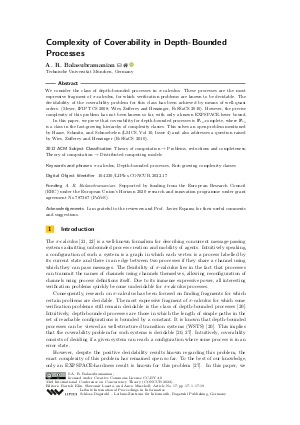@InProceedings{balasubramanian:LIPIcs.CONCUR.2022.17,
author = {Balasubramanian, A. R.},
title = {{Complexity of Coverability in Depth-Bounded Processes}},
booktitle = {33rd International Conference on Concurrency Theory (CONCUR 2022)},
pages = {17:1--17:19},
series = {Leibniz International Proceedings in Informatics (LIPIcs)},
ISBN = {978-3-95977-246-4},
ISSN = {1868-8969},
year = {2022},
volume = {243},
editor = {Klin, Bartek and Lasota, S{\l}awomir and Muscholl, Anca},
publisher = {Schloss Dagstuhl -- Leibniz-Zentrum f{\"u}r Informatik},
address = {Dagstuhl, Germany},
URL = {https://drops-dev.dagstuhl.de/entities/document/10.4230/LIPIcs.CONCUR.2022.17},
URN = {urn:nbn:de:0030-drops-170809},
doi = {10.4230/LIPIcs.CONCUR.2022.17},
annote = {Keywords: \pi-calculus, Depth-bounded processes, Fast-growing complexity classes}
}

 Creative Commons Attribution 4.0 International license
Creative Commons Attribution 4.0 International license

